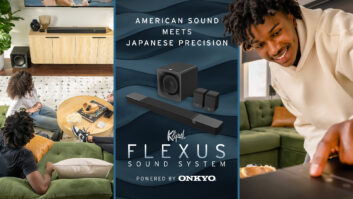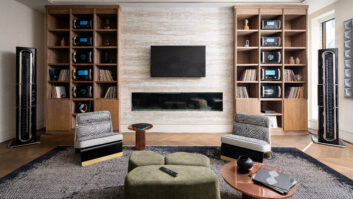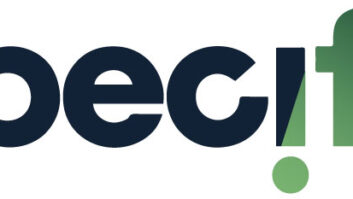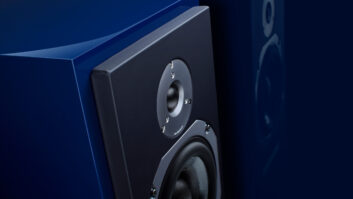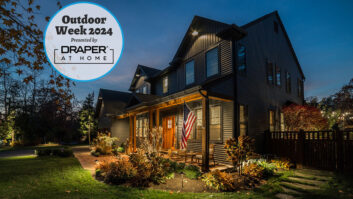From higher performance, smaller-aperture, designer-friendly architectural speakers to installation-friendly structural enhancements and components, manufacturers of loudspeakers in the custom integration channel are working hard to stand out from crowded field of competitors.
Leon Speakers’ Noah Kaplan is looking to start a “new conversation” in the CI channel that isn’t just about audio performance, but one that focuses on design. “Technology is growing at a rapid pace, so a lot of our newest products, like the Horizon Interactive FIT, look to create design-friendly solutions for incorporating today’s technologies into the home,” he said. “While there will always be architectural and invisible speakers, we’re working on solutions that are so beautifully designed that they don’t have to be hidden away.”
Leon responded to the popularity of massive displays with higher performance speakers that will really deliver on sound. “We recently redesigned our entire flagship SEVEN Series speaker line, which brings the theater-quality sound that people are looking for to any living space–not just dedicated home theaters,” Kaplan said.
Triad’s Designer Series architectural speakers and a garden array outdoors.
Revel’s patented acoustic lens waveguide technology continues to serve as a differentiator for the brand.
The TDG Audio Skybar LCR and Skybar Satellite are good examples of addressing the demand for quicker installations without any compromise in sound quality.
Triad’s Designer Series architectural speakers and a garden array outdoors.
Meridian’s DSP320 with back box and frame
Triad’s Designer Series architectural speakers and a garden array outdoors.
Nuvo’s outdoor speakers are IP65 rated and landscape speakers are Mil-810 rated.
Last year, Leon launched its UX Line of ultra-thin speakers to match the profiles of thinner TVs. “We worked with world-class engineers to ensure that they sound better than ever too,” he said. The company also developed its OTO MCA 200 modular control amplifier that can power any of our speakers to provide local power and control.
For Leon, however, it always comes back to custom. “While a lot of our business is making the custom-width soundbars that we’re known for, it goes so much further than that,” Kaplan said. “Custom is continuing to drive our business, and we’ve been busier than ever designing some amazing pieces for all sorts of clients–from a hardwood cypress-finished system for Mike Gordon from Phish, to 734 custom speakers for Apple Park in Cupertino.”
Patrice Congard, CEO and designer of the Audio Excellence sound system, and Screen Excellence believes that there are only two major trends that have been dominant over the long history of loudspeaker design: sound quality and size reduction. “I don’t think that loudspeaker design should follow ‘fashions,’ as it is an exact science. However, sound system design, which is different from loudspeaker design, involving a plurality of loudspeakers, amplifiers, and sometimes external crossovers (DSP) do seem to follow trends. This is mainly due to the fact that most installers struggle with this topic, so, when they see a layout that works, they tend to reproduce it. This is how a trend is created.”
Instead, Congard says, a logical and knowledgeable approach can lead to more consistent results. “It is not very difficult, as there is a model that exists, an absolute reference: the commercial theater layout,” he explained. “The only challenging part is to adapt it so as to fit the system in a much smaller residential space.”
The main idea in Audio Excellence loudspeaker design, according to Congard, is not to consider the loudspeaker as a product, but as a part of a sound system. The sound system design sets requirements for each loudspeaker, resulting in a design brief. “So, I started with typical sound system designs, including various options such as channel count, 3D audio, and room sizes. Then I designed the loudspeakers to meet the requirements, bearing in mind to keep them as versatile as possible. We ended up with three speakers types only in the Vertex series (limited range operating above 100 Hz) and two speakers types in the Raijuu series (subwoofers). This covers about 95 percent of the possible installations. Only very large installations requiring a sound field coverage extending beyond 50 feet from the screen cannot be achieved with existing loudspeakers of the Vertex range. We are considering extending the series to cover this need.
Bryston’s James Tanner says that with his company’s SP4 cinema processor, the company is seeing increased demand for high-performance architectural speakers for home theater applications. To answer the call, Bryston Model T series and Model A series speakers are now available as in-wall solutions, expressly for clients who are building Atmos/immersive multi-channel systems, he noted. Additionally, the company recently introduced active architectural speaker solutions using its BAX-1 crossover and advanced DSP processing.
“The advantage here is that the amplifier is directly connected to each driver, removing the passive crossover components from the signal path,” Tanner said. “Also, the DSP in the BAX-1 enables integrators to tune the low frequencies to match room acoustics. We also now offer a 24B3 Cubed Series 6-channel amplifier that reduces the rack space and cost associated with an active solution. Our active architectural speakers are really a very fine approach to superb quality playback from a discreet in-wall form factor.”
James Loudspeaker is experiencing a shift driven by market demand toward smaller, designer-friendly high-performance entertainment solutions. These products must feature a compact form factor and be customizable physically and/or cosmetically to quickly suit the needs of each client.
“Our Small Aperture speakers, Power Pipe subwoofers, and sound bar solutions are just a few examples of how James Loudspeaker is delivering the products integrators must have to satisfy their customers,” stated Mark Schafle, CEO of the company.
Schafle says that the market has proven to be very intolerant of those who cannot adjust to trends and deliver solutions quickly. “Take sound bars as an example; what used to take us 10-14 days of design/manufacturing process now takes us two to three days, and there are still ways that we can improve upon delivery times,” he said. “Optimally, we need to be able to respond the same day with custom solutions. In order to move in this direction, we have increased the sophistication of our work force to maximize our in-house CNC capabilities and capacities.”
Cary Christie, chief technology officer for audio at Savant-owned Artison says that his brand’s emphasis is on new minimum-aperture in-ceiling speakers and developing invisible solutions to address the market demand for small- or zero-footprint speakers for home entertainment.
“Consumers want modern designs that are minimally invasive,” he explained. “There is also a growing demand for architectural theater products, and Artison currently offers combinations of elegant, horizontal, and vertically arrayed sound solutions to be used with our Mezzanine in-ceiling speakers and Nano compact subwoofer for stunning décor-friendly home cinema.”
Christie contends that Artison has focused on seamlessly integrating fine audio solutions into any décor since back in 2003. New technologies, however, have enabled the brand to improve performance from smaller form factors seen in its lineup of sound bars, Dual Center Channel speakers, compact subwoofer, and new designs due out later this year.
Lenbrook CI product manager, Joe De Jesus, says that as the custom installation channel matures, PSB has become considerably more focused on how its products fit into the overall project. “We have paid special attention to the business aspect of the CI channel by making products that are fast and easy to install while also having aesthetics that address today’s interior design trends,” he said. “In short, we’ve considered everyone that has anything to do with our product throughout the life cycle of the project to support what is relevant to their needs.”
To the system designer, PSB tries offer as much versatility as possible with the smallest numbers of models. A tighter SKU base allows a designer the capability to deal with virtually any scenario he faces while keeping inventory simple and turns and profits high. “Whether it is a room with three glass walls, a vaulted ceiling, or an interior designer telling you that you are not allowed to put anything on that front wall, it is the CI firm’s job to come up with an answer,” De Jesus said. “These solutions may require any combination of in-wall, on-wall, or traditional in-room speakers. Our mission over the past several years has been to ensure that the sonic characteristic of our products in all said categories are very similar. It is a crucial factor in the success of an install.”
To simplify installations, PSB has a preconstruction bracket that in designed to be especially easy to install. The company also has created an integrated acoustic back can for its architectural speakers and offers a square grill kit for applications that require it. “These things may not seem important, but to the person who spends his days on a ladder it makes all the difference in the world,” De Jesus said.
Alex Zaliauskas, director of audio at Nortek Security& Control, said that the installation flexibility of 70-volt systems is an option demanded by more and more integrators selling SpeakerCraft and Niles. The challenge, he says, is delivering an exceptional audio experience that will delight the customer. “Our goal for each was to bring an indoor quality audio experience,” Zaliauskas added. “We think we’ve achieved that while maintaining the sonic signature of each line. Beyond sound quality, we’re using weatherproof fiberglass reinforced ABS enclosures and nickel-plated brass fittings for increased durability and long-lasting performance.”
An adjustable tap switch on the satellites enables them to operate in either traditional 8ohm mode, as well as 70V or 100V modes. This also enables multiple speakers on a single run to each play at a different volume, such as louder by the pool while quieter by the seating area. To speed up installations and ensure secure and long-lasting performance, the company introduced essential installation accessories to the lines, including stake mounts, surface mounts, and conduit box mounts.
The company also addressed home theater object-based audio with its SpeakerCraft Dolby Atmos enabled in-wall height speaker, the ATX-100. A height speaker is also part of the new Proficient Cabinet Loudspeaker line as well, for projects not using architectural speakers, according to Bill Hensley, senior director of marketing at Nortek Security & Control.
Dr. Jack Oclee-Brown, head of acoustics at KEF’s UK headquarters in Maidstone, Kent, UK, says that his company is seeing an increased amount of interest in high-performance in-walls. “People are realizing they can get extreme performance and a much less intrusive system with an installation speaker, so we’ve been working to incorporate some of our high-end speaker technology into our custom installation range,” he said.
KEF’s Uni-Q driver technology, which offers a consistent soundstage over a wide listening area, continues to set the brand apart, Oclee-Brown noted. “KEF has been using it in Hi-Fi market for many years, but it is totally appropriate for custom installers, offering a huge benefit for use in-ceiling and home theaters,” he said. “This gives us performance other manufacturers find hard to match.
Monitor Audio product design director Charles Minett noted that his brand’s team likes to look at trends outside custom install audio–such as lighting and home automation–to find out what architects and integrators expect from the fit and finish of the install. “Both our current and future products must allow us to deliver maximum performance but also offer integrators solutions that blend with other elements of a build or installation,” he said. “For example, our new flush-fit CF230 offers both square and circular install solutions. It uses a simple frame, installed before plasterwork is complete, which when complete blends seamlessly with the wall and keeps a perfect visual balance with high end install lighting and switches.”
In the last few months Monitor Audio has added a range of Installation Amplifiers to it line-up. “Featuring five new models, including three ‘connected models’ with DSP and Control4/Crestron control, we can really help our customers get the most out of our loudspeaker products,” Minett said. “We have put large amount of effort into how we tailor the design of our driver technologies to really step up performance when the install is complete rather than just test well in our labs and chambers. For example, on products such as the Platinum PLIC II rather than just evolve the RDT and MPD tweeter to work in a ceiling environment both the acoustic and product design teams worked together to integrate the drivers into a shape that would offer the best dispersion in a real-world listening environment.”
Mark Corbin, president of Vanco International, noted that one of the biggest trends influencing this company’s loudspeaker design development efforts is greater access to and ease of streaming content. “People tend to be either multi-room audio speaker customers or wireless speaker customers, and we offer solutions that cater to both customers through our PulseAudio and Beale Street Audio brands,” he said. “However, there is a pretty significant performance gap between wireless and traditional wired multi-room audio solutions. Our goal is to close that gap by developing products that work with our current audio solutions and provide homeowners with the accessibility to content and ease of control they desire throughout the home.”
Since acquiring the Beale Street Audio brand in 2017, Vanco has made a number of improvements, including improving the grade of carbon fiber and flute-injected poly cone materials for their driver, as well as enhancing driver and crossover components. Also, there were weaknesses in the mounting hardware and wire terminals that we have since addressed.
L. Paul Hales, owner and product designer for Pro Audio Technology, said that in the high-end distributed audio and dedicated home theater segment of the industry, his company is seeing a desire for better-sounding distributed loudspeakers and a widespread interest in immersive audio surround formats, particularly Dolby Atmos.
“The difference in performance of traditional 7.1 surround sound and high-channel count Dolby Atmos is easily heard and appreciated by everyone–even non-audiophiles–and this has led to revitalized interest in audio in general,” he said. “Our dealers are finding that once a customer hears a Dolby Atmos demo, they are eager to upgrade their current home theater system, or in many cases build out entirely new system.”
Hales also has noticed a desire for high-quality audio solutions that can be incorporated into multi-purpose living spaces. This is as a result of the increase in open concept homes. Most recently, PRO designed the SCRS-25im in response to specific dealer needs for a smaller, more accessible in-wall loudspeaker that can be installed anywhere from a dedicated theater room to a multi-purpose living space, and yet still provide the uncompromised signature PRO sound found in our larger, more expensive loudspeakers. “We continue to listen to our dealers and create solutions to fit all installation types and sizes. Because PRO’s products are manufactured and built-to-order right here in the U.S., we can quickly address our customers’ ever-changing needs,” he said.
Gerald Willis, product manager for Nuvo says that bringing convenience and premium performance to a variety of form factors has always been his brand’s focus, and that will continue. “Our newest outdoor speaker offerings from Nuvo have been very well received, offering both wired and wireless choices with the sound bar and table top speaker that also incorporate the Nuvo Players. We continuously strive to bring products to our clients that will provide the solutions they need to be successful,” he said. “We continuously strive to bring products to our clients that will provide the solutions they need to be successful.”
Willis noted that Nuvo’s recent launch of its Two, Four, and Six series speakers have done that very well and offer great performance, ranging from entry-level to premium price points. The brand shifted the cosmetics of its speakers “to something more sleek as well as convenient” with new rimless magnetic grills that blend into any room. To ensure that their clients have peace of mind about service calls, Nuvo’s outdoor speakers are IP65 rated and landscape speakers are Mil-810 rated. Traditionally, outdoor speakers with those ratings would cost significantly more, making Legrand’s offering a tremendous value.
Kordon Vaughn, senior director of product marketing, Control4, said that while sound quality is his company’s priority when designing loudspeakers for the Triad brand, décor and interior design continue to be driving factors in the decision-making process, a well.
“Over the past year, Control4 released a number of new products in the Triad speaker line that disappear into the décor while offering superior audio quality throughout the home and garden,” he said. “As a result, our dealers now have custom audio solutions that can be easily specified into just about any type of residential AV installation.”
In 2017, Control4 introduced the Triad Designer Series, comprised of in-ceiling speakers that deliver improved audio quality by projecting the sound from three drivers through a tiny, four-inch speaker grill. The series includes a full-range speaker and subwoofer designed for superior audio performance and aesthetics. All speaker components can be replaced through the 4-inch opening without special tools and without having to tear open the ceiling. The company has also developed products with a focus on wide dispersion–including the Designer Series and Garden Array Outdoor Series.
The DaVinci Group (TDG) has seen a growing number of integrators opting for simpler and quicker installations, noted CEO and president Jeff Francisco. “While the drive may be to simplify the installation, it does not mean that costs are being cut on products,” he said. “We see that integrators and homeowners that are willing to spend more money on fewer products. Complementing the demand for simplification is the push toward more sophisticated media rooms rather than full dedicated home theaters. This trend is responsive to the changing viewing and listening habits of consumers.”
TDG, Francisco says, has worked hard on more premium solutions while targeting specific products that can be best-in-class solutions for the trends the company is witnessing. “We have found success in pulling away from a broad assortment of products in each category and instead providing integrators specific solutions,” he said. “In the past, we may have created two or three versions of the same product whereas now we offer just one optimized solution.”
The TDG Audio Skybar LCR and Skybar Satellite are good examples of addressing the demand for quicker installations without any compromise in sound quality. Rather than cutting holes for seven speakers into a ceiling for a 7.1 theater system the installer can simply cut three opening and have a great sounding in-ceiling solution.
“We do this by combining multiple channels into single enclosures while delivering high-end performance through the utilization of high quality materials and design,” Francisco said. “This product was created with the direct input of our dealers who were asking for a simpler look and installation.”
In outdoor audio TDG addressed the demand for quick installation while still providing high performance with the design of our OS-SUB 10-inch outdoor subwoofer.
“Our dealers told us that they wanted the performance of a buried subwoofer without going through all the hassles of digging a big hole,” Francisco explained. “The SUB-10 can be surfaced mounted or partially at the dealer’s option buried, and does not occupy a large amount of space.”
Dennis Holzer, executive director of the PowerHouse Alliance also points to the desire for speakers that can be heard but not necessarily seen, as a predominant trend. “Today, the average customer is not interested in large freestanding loudspeakers that take up space in their entertainment area,” he said. “Instead, they prefer in-wall and in-ceiling speaker options that provide all the advantages of a good sounding system without interfering with their décor.”
Not just any in-wall or in-ceiling speaker will do, however. “Feedback from our dealers and their customers is a preference for low-profile magnetic grills with little-to-no visible speaker bezels, as well as a consistent white finish across all models so that speakers blend seamlessly into the ceiling and walls from room to room regardless of the shape or size. These are all product features we considered when designing the exclusive A2V line of in-wall and in-ceiling speakers, introduced to PowerHouse Alliance distributors and dealers late last year.”
Katy Bradshaw, director of marketing at Meridian, said that her company is experiencing a greater demand for a variety of in-wall and in-ceiling loudspeaker solutions, with more and more integrators specifying discreet, unobtrusive solutions for their clients.
“Customers have become accustomed to integrated technology in the home, and are looking for loudspeakers with a sleek, slim design to match today’s modern TV screens and compact devices, which also boast high-performance levels and a seamless, cable-free look,” she said.
To meet current demand, Meridian has focused its attention on designing and manufacturing discreet audio solutions, with slim in-wall and in-ceiling loudspeakers at the forefront of this development. “Our current products are only 103mm (~4 inches) deep, requiring minimal space whilst providing maximum impact,” she said.
The company’s Digital Active loudspeakers are designed with built-in Meridian Enhancement technologies and the DSP320 in-ceiling/in-wall loudspeakers come equipped with the company’s Centre Image Elevation technology to raise the image location from an under-screen loudspeaker, so that it appears to come from the center of the screen or as desired. Its compact size leaves more space in the rack and ensures it produces minimal heat, resulting in a better audio performance for the client, and ease of installation for the integrator. Enhanced Bass Alignment (EBA) technology enables accurate time-alignment of the high, mid, and bass frequencies reproduced by Meridian’s loudspeakers, ensuring that all the sounds reach the listener at the same time, providing exceptional imaging and a clear, transparent, life-like sound. Meridian High Resolution (MHR) allows the secure movement of high-resolution digital audio within a Meridian system, without degradation or loss in quality.
Jim Garrett, senior director, product strategy and planning for Harman Luxury Audio, said that the major trends his team sees now relate to loudspeaker design. “With our range of in-ceiling and in-wall Revel loudspeakers, we are using zero-bezel grilles that provide an unobtrusive look that allows the loudspeaker to blend in seamlessly with its surroundings. The ultra-thin design attaches magnetically and completely covers the speaker. The lack of a traditional bezel on the speaker also reduces labor when painting the grilles.”
Revel’s patented acoustic lens waveguide technology continues to serve as a differentiator for the brand. Additionally, Revel was one of the first manufacturers to introduce a zero-bezel design, and its patented installation mechanism doesn’t require clamping to the drywall and can accommodate a variety of wall thicknesses and construction types, Garrett pointed out.
Origin Acoustics looks at the loudspeaker category in three segments: interiors music distribution, exterior music distribution, and home theater/media room. The company believes that while technologies to provide distribution and control have advanced exponentially in the last few years, the need for high quality loudspeakers to reproduce the music with a “modicum of fidelity” is still very real.
“We design a broad range of architectural speakers and subwoofers for this purpose–everything from entry-level models for production homes to high-performance units for the more discriminating listener,” said Dave Donald, worldwide ambassador for Origin.
Sonically, the DPSD tweeter and X-Wave surround on Origin’s woofers and midrange drivers are innovations that have set what the company believes is a new standard for architectural loudspeakers.
“Additionally, we are able to fit an 8-inch driver into a space normally reserved for a 6.5-inch speaker, and a 10-inch driver into a space normally reserved for an 8 inch,” Donald said. “This ‘More Bass, Less Space’ ability means dramatically improved frequency response from an installation that remains very aesthetically pleasing.”
Origin’s tool-less mounting system also provides the ability to install mounting hardware and grilles early in the project and snap the speaker itself into place at the last minute.
Michael Buratto, product manager, component audio for Klipsch Group, also noted that customers are becoming more discerning when it comes to how products integrate into their interior design. Klipsch, he said, has traditionally been a performance-first speaker company with “bold, unapologetic designs,” but not every customer is willing to sacrifice looks for pure audio performance.
“As lighting and other ceiling and wall fixtures get smaller, we are creating discrete, design-focused audio solutions that deliver the legendary Klipsch sound that customers have come to love,” he explained. “The new Klipsch Professional Series Reference architectural speakers feature three ‘small aperture’ models (one in-ceiling, two in-wall) that shrink the traditional architectural speaker design into a form factor that is much slimmer and more modern looking. The Pro-14RC in-ceiling speaker has a grille width under 5 inches, so it matches the diameter of most down-can lights for a consistent, seamless look in a modern living space. Our Pro-800SW in-ceiling band pass subwoofer has a port tube with the same grille as the Pro-14RC, so when used together, it is a full range distributed audio system without large or mismatched grilles in the ceiling.”
The company’s two in-wall models, the Pro-14RW and Pro-24RW LCR, are designed for distributed audio, 2-channel listening, and surround sound systems in smaller rooms. Both models feature 4-inch woofers, which allows for a much smaller visual footprint in the room and more modern look, especially when paired with today’s ultra-slim TVs.










